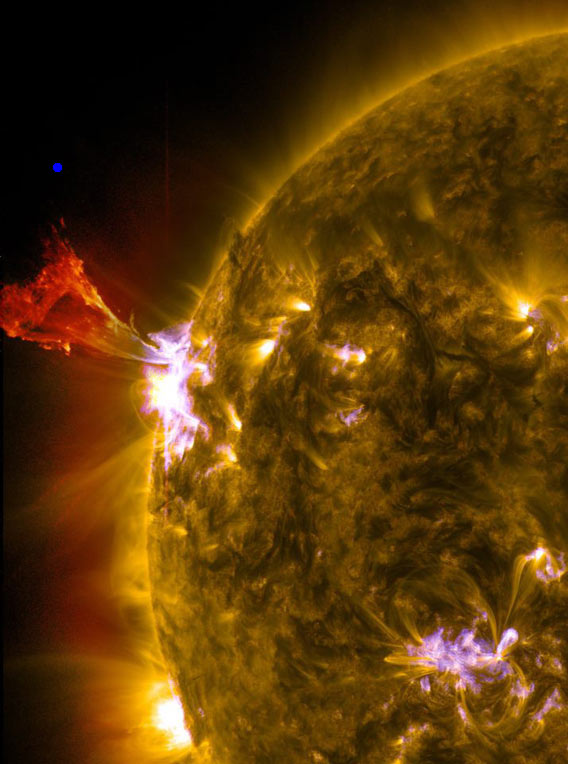Create a free profile to get unlimited access to exclusive videos, sweepstakes, and more!
Twisting Solar Eruption

Yesterday, May 3, 2013, a sunspot was pushed past its limit. The colossal energy stored in its magnetic field erupted, blasting out a relatively weak solar flare. But it was enough to trigger a magnificent, towering spire of plasma that reached the dizzying height of roughly 200,000 kilometers (120,000 miles) over the surface of the Sun before the material thinned out too much to see.
The image above is a combination of three different shots taken by NASAâs Solar Dynamics Observatory, each in the ultraviolet where such magnetic activity is easiest to see (I added the blue dot, which is roughly how big the Earth is, just to give you a sense of scale and to crush your brain). I also created a video of the event using Helioviewer.org; it shows about three hours of solar activity compressed into 19 seconds:
Cooooool.
What you just saw is a pretty typical event for the Sun. Rising plasma (gas stripped of one or more electrons, giving it an electric field) inside the Sun has a magnetic field embedded in it. When it gets to the Sunâs surface, the magnetic field lines go up and down, piercing the surface. There can be quite a few of them, looping high over the surface, each storing more energy than all the nuclear weapons on Earth. The lines can get tangled, and if one of these loops crosses another, they can connect, like a short circuit. It releases its energy, which then twangs another loop, which snaps, and releases its energyâ¦
â¦and you get a sudden and explosive release of all that fury. Thatâs a solar flare (the flare itself from May 3 can be seen in the inset image). It perturbs everything around it, shaking the solar surface and the magnetic fields of other regions. In this case, it triggered an eruptive prominence, that huge tower of plasma. As the prominence rose, the magnetic field lines inside of it still hold sway, and you can see the top of it apparently twisting as it rises, flowing along those magnetic field lines (Iâve explained all this in more detail in an earlier post, too).
The Sun goes through a magnetic cycle, with its activity increasing from a minimum to a maximum over the course of about 5.5 years. Itâs recently stalled a bit, with fewer sunspots and fewer flares than expected. Itâs not at all clear if itâll start to ramp up again, or if weâve already passed the peak. The Sun is a bit like climate and weather; over long periods we can predict its climate, but over short periods its weather is a bit dicier to foretell. Weâll just have to wait and see what the future brings.
Tip oâ the welderâs goggles to Little SDO.


























